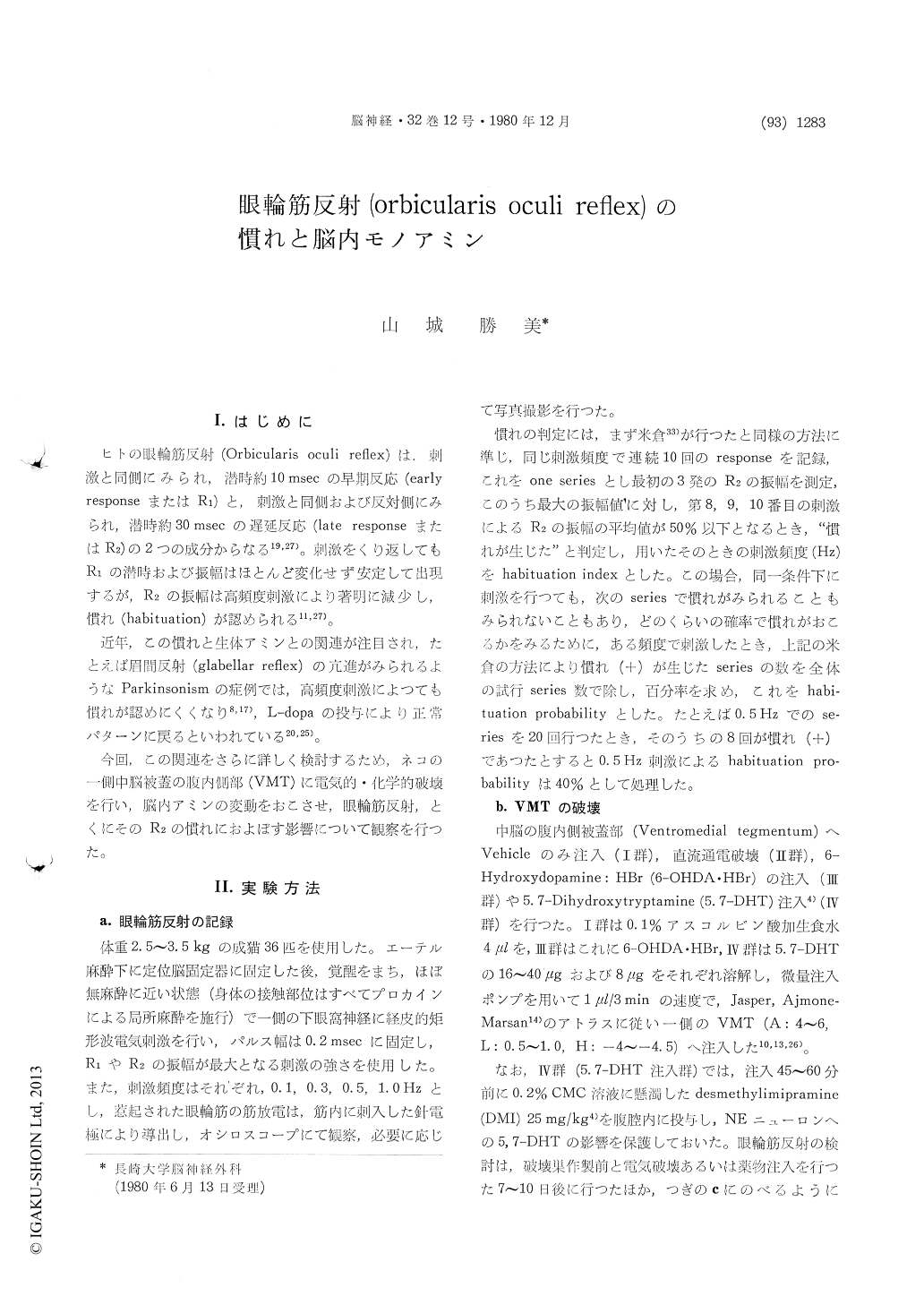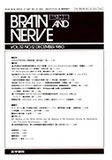Japanese
English
- 有料閲覧
- Abstract 文献概要
- 1ページ目 Look Inside
I.はじめに
ヒトの眼輪筋反射(Orbicularis oculi reflex)は,刺激と同側にみられ,潜時約10msecの早期反応(earlyresponseまたはR1)と,刺激と同側および反対側にみられ,潜時約30msecの遅延反応(late responseまたはR2)の2つの成分からなる19,27)。刺激をくり返してもR1の潜時および振幅はほとんど変化せず安定して出現するが,R2の振幅は高頻度刺激により著明に減少し,慣れ(habituation)が認められる11,27)。
近年,この慣れと生体アミンとの関連が注目され,たとえば眉間反射(glabellar reflex)の亢進がみられるようなParkinsonismの症例では,高頻度刺激によつても慣れが認めにくくなり8,17),L-dopaの投与により正常パターンに戻るといわれている20,25)。
The effect of biogenic amines upon the habitua-tion of the late component (R2) of blink reflex was studied in unanesthetized cats.
In order to decrease an amount of brain mono-amines unilaterally, one side of the ventro-medial tegmentum (VMT) of the midbrain was treated electrically or chemically. I. control (vehicle in-jection), II. electrocoagulated, III. 6-hydroxydopa-mine (6-OHDA) was injected and IV. 5, 7-dihyd-roxytryptamine (5, 7-DHT) was injected.
Blink reflex was evoked by stimulating the in-fraorbital nerve. The frequency varied successively from 0.1Hz to 0.3Hz, 0.5Hz and 1Hz. Whether or not an appearance of the habituation was dicided by the method used by Yonekura et al. (1977). For this purpose, the first serial 10 reflexes were photographed and analyzed as one trial (series). Furthermore, changes in difficulty of the habitua-tion after VMT lesion were evaluated according to the"Habituation probability"in which a relation of the number of habituated series for the number of total trials was calculated and expressed in terms of percentage. For example, if stimulation was made with 0.5Hz and habituation was observed at 8 times (series) during total of 20 times trials, habi-tuation probability was expressed as 40% at given (0.5Hz) stimulation frequency.
An amount of NE, DA and 5-HT of the cere-bral cortex and striatum was measured at both side, and in group I (control), no difinite change was observed before and after the VMT treatment. Contrariwise, in group II: all of these amines, in group III: markedly NE and DA, in group IV: mainly 5-HT, were depleted respectively at the lesion producing side.
Changes in brain monoamines produced by the VMT treatment, had little effect on latencies and amplitudes of blink reflex, but, obvious influence was noted upon the habituation of R2.
In group II, III and IV, the habituation of R2 was difficult to occur in the lesioned side as com-pared to that observed in group I. In these three groups, there also noted a definite difference to evoke the habituation between the lesioned and the non-lesioned side. They showed a tendency to return to the control pattern after monoamine precursor was given. It was suggested that the habituation of R2 was related to a dose of brain monoamine and which decrease resulted in a dif-ficulty to evoke the habituation of R2. A detail of its mechanism was not clear.

Copyright © 1980, Igaku-Shoin Ltd. All rights reserved.


